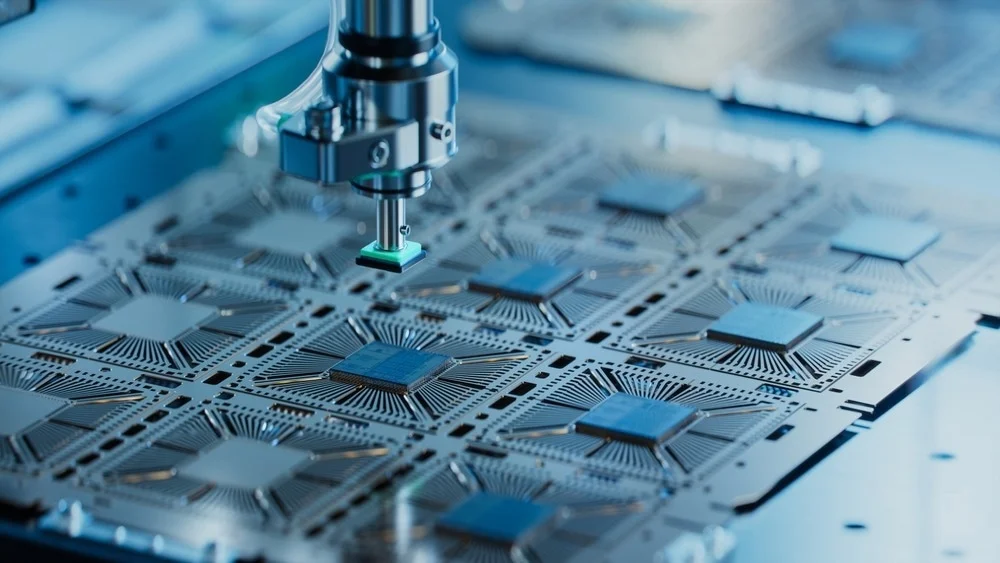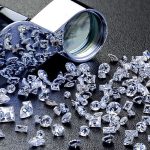Goldman Sachs Reveals 3 Must-Own Semiconductor Equipment Stocks for AI's Next Wave.
[Published: July 11, 2025]
If you've been following the market lately, you know that semiconductors have been absolutely on fire, especially with all the buzz around Artificial Intelligence (AI) and cloud computing. Companies like NVIDIA have seen incredible runs, but what if there's another, less obvious, sweet spot in the tech world that's just getting warmed up?
Well, the sharp minds at Goldman Sachs certainly think so. They've just started covering the Semiconductor Capital Equipment sector, and they've given a solid "Buy" rating to three major players that are absolutely essential to the entire chip-making process.
Think of it this way: While everyone's focused on the fancy cars (the chips), Goldman Sachs is pointing to the companies that build the state-of-the-art factories and tools for those cars. This often means more stable growth and potentially less volatility than the chip designers themselves.
Nvidia's Trillion-Dollar Question: Will AI Catapult NVIDIA to Unprecedented Gains in the Next 5 Years?
According to Goldman's deep dive, this industry is currently in a "mid-cycle" phase. What does that mean for you? It suggests a fairly stable path ahead for revenue through 2026, thanks to factors like continued chip innovation for AI and the ongoing push for countries to build their own chip factories. It's a balance of old challenges and exciting new opportunities.
So, if you're a growth investor looking for a smart way to tap into the booming tech sector – especially with some attractive dividends – these three companies highlighted by Goldman Sachs are definitely worth a closer look.
Why These "Behind-the-Scenes" Tech Stocks Are So Compelling
You might be asking, "Why focus on the equipment makers when the chip companies are making all the headlines?" That's a great question! Goldman Sachs' perspective is that while chipmakers ride the waves of product cycles, the companies that provide the crucial machinery are always in demand. Every new chip generation, every new factory, every technological leap needs their specialized tools and expertise. This fundamental role often makes them incredibly resilient and vital to the entire tech ecosystem.
Goldman Sachs' Top "Buy" Picks: Your Inside Scoop
1. Applied Materials (NASDAQ: AMAT)
Building the Factories of Tomorrow
Applied Materials is truly a giant in the industry. Imagine a company that provides all the high-tech machinery, software, and services needed to build the most advanced semiconductor chips and even the screens for your TVs and smartphones. That's AMAT. They're literally designing the factories where the future of tech is born.
Goldman Sachs is bullish on AMAT because they're deeply embedded in the most advanced chip manufacturing processes. Whether it's making the tiniest components or building massive display panels, AMAT's tech is crucial. This puts them right at the heart of the AI revolution, as increasingly complex chips require their cutting-edge solutions. Plus, they offer a nice dividend for patient investors.
- Quick Look:
- Market Value: Around $159 Billion
- How Pricey? P/E Ratio of 24.06
- Dividend Yield: 1.01%
- Goldman's Price Target: $225
2. Lam Research (NASDAQ: LRCX)
The Brains Behind the Wafer
Lam Research is another powerhouse in the wafer fabrication world. If Applied Materials builds parts of the factory, Lam Research provides the incredibly precise tools that etch and deposit materials onto silicon wafers, layer by microscopic layer, to create the actual chips. They're masters of nano-scale engineering.
What gets Goldman Sachs excited about Lam Research? Their essential role in the very precise steps of chip manufacturing. As chips become more intricate and packed with more transistors (especially for AI), the demand for Lam's specialized equipment skyrockets. They're critical partners for memory makers and foundries alike, benefiting directly from the increasing complexity of modern electronics.
- Quick Look:
- Market Value: Around $128 Billion
- How Pricey? P/E Ratio of 27.80
- Dividend Yield: 0.95%
- Goldman's Price Target: $115
3. Seagate Technology (NASDAQ: STX)
Storing the World's Data
You might know Seagate Technology for the hard drives in your computer, but they're much more than that. They're a massive player in the world of mass data storage, which is absolutely vital for everything from giant cloud data centers to AI training. The more data we create, the more their solutions are needed.
Goldman Sachs sees a bright future for Seagate, especially as the demand for high-capacity storage from cloud providers and AI companies explodes. Seagate's new HAMR (Heat-Assisted Magnetic Recording) technology is a game-changer, allowing for even larger hard drives, and Goldman expects a big surge in its adoption by major tech companies by late 2025 and 2026. This could help Seagate grab more market share and really drive revenue. Plus, it offers the highest dividend yield of the three.
- Quick Look:
- Market Value: Around $31 Billion
- How Pricey? P/E Ratio of 20.46
- Dividend Yield: 2.00%
- Goldman's Price Target: $170
Strategic Investment in a Growing Sector
The semiconductor capital equipment sector offers a compelling blend of fundamental necessity, innovation, and long-term growth potential. Goldman Sachs' high-conviction "Buy" ratings on Applied Materials, Lam Research, and Seagate Technology provide a strong signal for investors looking to capitalize on the foundational elements of the global technology expansion.
Thinking about adding these to your portfolio? It's always a good idea to conduct your own thorough research and consider consulting with a qualified financial advisor to determine how they fit with your personal financial goals and risk tolerance.
Sources:
- Goldman Sachs Research: Goldman Sachs initiated coverage on the US Semiconductor Capital Equipment, Storage, and Foundry sectors on July 10, 2025. This report provides the "Buy" ratings and price targets mentioned for Applied Materials, Lam Research, and Seagate Technology, along with the detailed industry outlook and "mid-cycle" dynamics assessment.
- Editor's Note: Specific page numbers or a direct link to the proprietary Goldman Sachs report are not publicly available without a subscription. This article's information is based on public financial news coverage of the Goldman Sachs report, which is common practice for conveying analyst ratings.
- Company Financial Data: Market capitalization, P/E ratios, and dividend yields are current as of market close on July 10, 2025, and are widely available from reputable financial data providers such as NASDAQ, Google Finance, and other financial news outlets.
- Semiconductor Industry Outlook: General market trends and forecasts regarding semiconductor capital equipment spending for 2025-2026, including the impact of AI and onshoring, are supported by reports from industry associations like SEMI (Semiconductor Equipment and Materials International) and various market research firms.
People Also Ask (PAA) / Frequently Asked Questions (FAQ)
Q1: Why is Goldman Sachs suddenly interested in Semiconductor Capital Equipment stocks?
A1: Goldman Sachs isn't "suddenly" interested, but they've recently initiated specific coverage on this sector, indicating a fresh, favorable outlook. They believe that while the broader semiconductor chip industry has seen massive gains, the capital equipment sector (the companies that make the machinery for chips) offers a potentially undervalued opportunity. They see the industry in a "mid-cycle" phase with stable revenue dynamics, driven by AI demand and ongoing global efforts to build more chip factories.
Q2: How does the "mid-cycle" phase affect these stocks?
A2: A "mid-cycle" phase, as described by Goldman Sachs, suggests a period of relatively stable revenue for the Semiconductor Capital Equipment industry through 2026. This means consistent demand for their products and services, even if growth isn't explosive, due to factors like leading-edge foundry demand (for AI) and strategic onshoring efforts by various countries. It implies a more predictable and potentially less volatile investment environment compared to early-cycle boom-bust scenarios.
Q3: What is "onshoring" and how does it impact these companies?
A3: Onshoring refers to the trend of countries bringing semiconductor manufacturing back within their own borders, rather than relying solely on overseas production. Governments, particularly in the US (with the CHIPS Act), EU, and China, are investing heavily to build new domestic fabs (fabrication plants). This directly benefits semiconductor capital equipment companies like Applied Materials and Lam Research, as they provide the essential tools and machinery needed to set up and operate these new facilities.
Q4: Are these dividend stocks suitable for all investors?
A4: These stocks, as highlighted by Goldman Sachs, offer a combination of growth potential within the technology sector and regular dividend income. They can be suitable for growth-oriented investors who also appreciate a dividend. However, like all investments, they carry risks. It's crucial to consider your individual financial goals, risk tolerance, and investment horizon, and perhaps consult with a financial advisor, before making any investment decisions.
Q5: What makes Applied Materials, Lam Research, and Seagate Technology specifically attractive according to Goldman Sachs?
A5:
- Applied Materials (AMAT): Valued for its fundamental role in materials engineering for chip and display manufacturing, benefiting from complexity driven by AI.
- Lam Research (LRCX): Praised for its critical equipment in wafer fabrication, particularly in essential etch and deposition processes vital for advanced chip architectures.
- Seagate Technology (STX): Identified as a key player in mass data storage, poised to benefit from surging demand from cloud and AI, particularly with its new high-capacity HAMR technology. Goldman Sachs sees these companies as integral to enabling the broader semiconductor boom.
Q6: Where can I find the full Goldman Sachs report?
A6: Goldman Sachs' detailed research reports are typically proprietary and available to their institutional and high-net-worth clients, or through financial terminals like Bloomberg and Refinitiv. Public financial news outlets often summarize these reports, which is the basis for the information provided in this article. Without a direct subscription or access, the full report is generally not publicly available.















